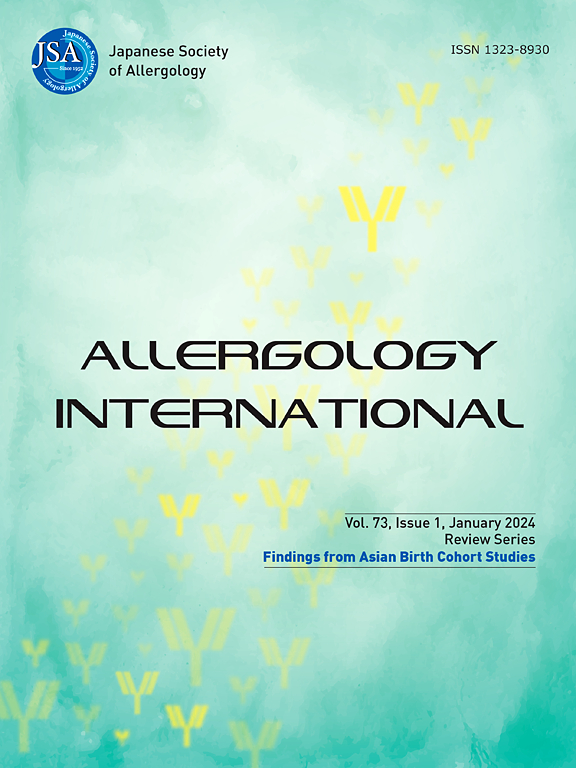日本儿童特应性皮炎皮肤健康调查:东北医学大型数据库项目出生和三代队列研究。
IF 6.7
2区 医学
Q1 ALLERGY
引用次数: 0
摘要
背景:要准确诊断特应性皮炎(AD),精确的皮肤表型数据必不可少。因此,本研究考察了两位皮肤科医生对特应性皮炎和非特应性皮炎诊断的观察者间一致性。研究利用皮肤健康调查数据,将根据医生自我报告诊断确定的特应性皮炎发病率和根据英国(UK)诊断标准确定的特应性皮炎诊断与两位皮肤科医生的诊断进行了比较:这项研究包括参加皮肤健康调查的 1638 名儿童,该调查是东北医疗大数据库项目出生和三代队列研究的一部分。通过皮肤科医生的评估、医生的自我报告诊断以及英国诊断标准对注意力缺失症进行了评估。诊断的一致性使用卡帕进行评估。通过将自我报告的医生诊断和英国诊断标准与两位皮肤科医生的诊断进行比较,计算出两者的敏感性和特异性:在1638名儿童中,两名皮肤科医生、医生和英国诊断标准分别诊断出393名(24.0%)、194名(11.9%)和597名(37.2%)儿童患有AD。两位皮肤科医生对 AD 或非 AD 诊断的观察者间一致性卡帕(95 % CI)为 0.78(0.75-0.81)。医生自我报告诊断的敏感性和特异性分别为 26.7% 和 94.1%。英国诊断标准的敏感性和特异性分别为85.0%和82.4%:两位皮肤科医生对 AD 或非 AD 诊断的观察者间一致性很高。医生自我报告的诊断结果灵敏度较低,这可能表明 AD 诊断不足,而英国诊断标准可能会过度诊断 AD。本文章由计算机程序翻译,如有差异,请以英文原文为准。
Skin health survey on atopic dermatitis among Japanese children: The Tohoku Medical Megabank Project Birth and Three-Generation Cohort Study
Background
Precise skin phenotypic data are indispensable in accurately diagnosing atopic dermatitis (AD). Therefore, this study examined the interobserver concordance for AD and non-AD diagnoses between two dermatologists. AD prevalence determined by the self-reported physician diagnoses and the diagnoses determined from the United Kingdom (UK) diagnostic criteria were compared with the diagnoses made by the two dermatologists, using data from a skin health survey.
Methods
This study included 1,638 children that participated in the skin health survey, which was part of the Tohoku Medical Megabank Project Birth and Three-Generation Cohort Study. AD was assessed using dermatologist assessments, self-reported physician diagnoses, and the UK diagnostic criteria. The concordance for diagnoses was evaluated using kappa. The sensitivity and specificity of the self-reported physician diagnoses and the UK diagnostic criteria were calculated by comparing them with the two dermatologists’ diagnoses.
Results
Among the 1,638 children, 393 (24.0 %), 194 (11.9 %), and 597 (37.2 %) were diagnosed with AD by the two dermatologists, physicians, and the UK diagnostic criteria, respectively. The kappa (95 % CI) of the interobserver concordance for AD or non-AD diagnoses between the two dermatologists was 0.78 (0.75–0.81). The sensitivity and specificity of the self-reported physician diagnoses were 26.7 % and 94.1 %, respectively. The sensitivity and specificity of the UK diagnostic criteria were 85.0 % and 82.4 %, respectively.
Conclusions
Interobserver concordance for AD or non-AD diagnoses between the two dermatologists was substantial. Self-reported physician diagnoses exhibited low sensitivity that potentially indicated underdiagnosis of AD, whereas the UK diagnostic criteria might overdiagnose AD.
求助全文
通过发布文献求助,成功后即可免费获取论文全文。
去求助
来源期刊

Allergology International
ALLERGY-IMMUNOLOGY
CiteScore
12.60
自引率
5.90%
发文量
96
审稿时长
29 weeks
期刊介绍:
Allergology International is the official journal of the Japanese Society of Allergology and publishes original papers dealing with the etiology, diagnosis and treatment of allergic and related diseases. Papers may include the study of methods of controlling allergic reactions, human and animal models of hypersensitivity and other aspects of basic and applied clinical allergy in its broadest sense.
The Journal aims to encourage the international exchange of results and encourages authors from all countries to submit papers in the following three categories: Original Articles, Review Articles, and Letters to the Editor.
 求助内容:
求助内容: 应助结果提醒方式:
应助结果提醒方式:


